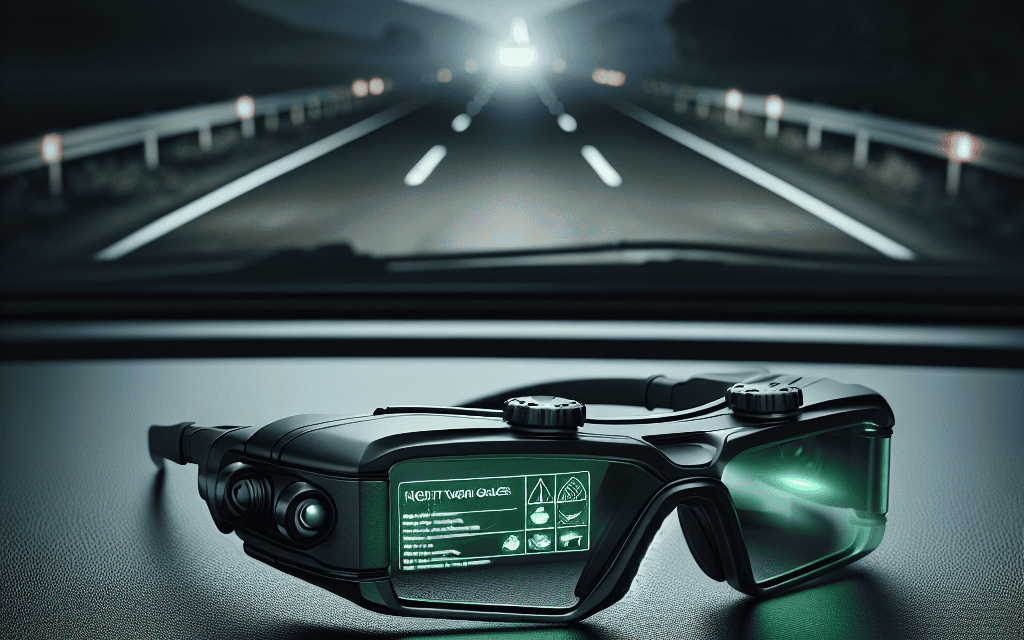Night Vision Eyewear: Boosting Safety for Nighttime Driving
Driving at night presents unique challenges that can significantly impair visibility and increase the risk of accidents. As the sun sets, the human eye struggles to adapt to low-light conditions, making it difficult to see obstacles, pedestrians, and other vehicles. Night vision eyewear has emerged as a potential solution to enhance visibility and safety during nighttime driving. This article delves into the various aspects of night vision eyewear, exploring its technology, benefits, limitations, and the impact it has on road safety.
Understanding Night Vision Technology
Night vision technology has evolved significantly over the years, transitioning from military applications to consumer products like night vision eyewear. The core principle behind night vision devices is to amplify available light, allowing users to see in low-light conditions.
How Night Vision Works
Night vision devices typically use one of two technologies: image intensification or thermal imaging.
- Image Intensification: This technology amplifies existing light, such as moonlight or starlight. It works by capturing photons (light particles) and converting them into electrons, which are then amplified and converted back into visible light. This process allows users to see in conditions where the naked eye would struggle.
- Thermal Imaging: Unlike image intensification, thermal imaging detects heat emitted by objects. This technology is particularly useful in complete darkness, as it does not rely on visible light. Thermal cameras can identify warm objects, such as vehicles and pedestrians, against cooler backgrounds.
Both technologies have their advantages and disadvantages, and the choice between them often depends on the specific needs of the user.
Types of Night Vision Eyewear
Night vision eyewear comes in various forms, each designed for specific applications. The most common types include:
- Clip-On Night Vision: These devices can be attached to regular eyeglasses, providing night vision capabilities without the need for specialized eyewear.
- Prescription Night Vision Glasses: For individuals who require corrective lenses, prescription night vision glasses combine vision correction with night vision technology.
- Full-Frame Night Vision Glasses: These are standalone glasses designed specifically for night vision, often featuring advanced coatings to reduce glare and enhance contrast.
Each type of eyewear has its unique features and benefits, catering to different user preferences and requirements.
The Benefits of Night Vision Eyewear for Nighttime Driving
Night vision eyewear offers several advantages that can significantly enhance safety for nighttime drivers. Understanding these benefits can help consumers make informed decisions about their eyewear choices.
Improved Visibility
One of the primary benefits of night vision eyewear is improved visibility in low-light conditions. Traditional headlights illuminate the road ahead, but they may not be sufficient to detect obstacles or hazards in time. Night vision eyewear enhances contrast and depth perception, allowing drivers to see further and more clearly.
For instance, a study conducted by the National Highway Traffic Safety Administration (NHTSA) found that nearly 50% of all traffic fatalities occur at night, despite only 25% of driving taking place during these hours. This statistic underscores the importance of visibility in preventing accidents.
Reduction of Glare
Glare from oncoming headlights can be blinding and disorienting for drivers at night. Night vision eyewear is often equipped with anti-reflective coatings that reduce glare, allowing for a more comfortable driving experience. By minimizing glare, drivers can maintain focus on the road and react more quickly to potential hazards.
According to a survey by the AAA Foundation for Traffic Safety, 80% of drivers reported experiencing glare from oncoming headlights, which can lead to temporary blindness and increased reaction times. Night vision eyewear can help mitigate these effects, enhancing overall safety.
Enhanced Depth Perception
Depth perception is crucial for safe driving, especially at night when visibility is compromised. Night vision eyewear can enhance depth perception by providing a clearer view of the road and surrounding environment. This improved perception allows drivers to judge distances more accurately, making it easier to navigate turns, merge into traffic, and avoid obstacles.
Research has shown that depth perception can be significantly impaired in low-light conditions. A study published in the journal “Optometry and Vision Science” found that drivers’ ability to judge distances decreased by up to 30% in dim lighting. Night vision eyewear can help counteract this effect, providing a safer driving experience.
Increased Confidence
Driving at night can be intimidating for many individuals, particularly those who are not accustomed to low-light conditions. Night vision eyewear can boost confidence by providing drivers with the tools they need to navigate safely. When drivers feel more secure in their ability to see and react to potential hazards, they are less likely to experience anxiety or hesitation on the road.
A survey conducted by the American Automobile Association (AAA) found that 60% of drivers reported feeling more confident when using night vision eyewear. This increased confidence can lead to safer driving behaviors and a reduction in accidents.
Potential for Reduced Accident Rates
Ultimately, the combination of improved visibility, reduced glare, enhanced depth perception, and increased confidence can lead to a significant reduction in nighttime accidents. A study by the Insurance Institute for Highway Safety (IIHS) found that the use of night vision technology could potentially reduce nighttime crash rates by up to 30%.
As more drivers adopt night vision eyewear, the overall safety of nighttime driving may improve, leading to fewer accidents and fatalities on the road.
Limitations and Considerations of Night Vision Eyewear
While night vision eyewear offers numerous benefits, it is essential to consider its limitations and potential drawbacks. Understanding these factors can help consumers make informed decisions about their eyewear choices.
Cost Considerations
One of the primary limitations of night vision eyewear is the cost. High-quality night vision devices can be expensive, with prices ranging from a few hundred to several thousand dollars. This cost may be prohibitive for some consumers, particularly those who only drive occasionally at night.
Additionally, the cost of maintenance and potential repairs should be considered. Night vision eyewear may require specialized cleaning and care to maintain optimal performance, adding to the overall expense.
Weight and Comfort
Some night vision eyewear can be bulky or heavy, which may lead to discomfort during extended use. Drivers may find it challenging to wear these glasses for long periods, particularly if they are not accustomed to wearing glasses in general. Comfort is a crucial factor for any eyewear, and consumers should prioritize finding a pair that fits well and feels comfortable during use.
Limited Field of View
Night vision eyewear may have a limited field of view compared to regular glasses. This limitation can hinder peripheral vision, making it more challenging to detect hazards outside the direct line of sight. Drivers should be aware of this limitation and remain vigilant while using night vision eyewear.
Dependence on Technology
While night vision eyewear can enhance visibility, it should not be relied upon as a substitute for safe driving practices. Drivers must remain attentive and focused on the road, regardless of the technology they are using. Over-reliance on night vision eyewear may lead to complacency and an increased risk of accidents.
Legal and Regulatory Considerations
In some regions, the use of night vision eyewear may be subject to legal and regulatory restrictions. Drivers should familiarize themselves with local laws regarding the use of night vision devices to avoid potential fines or penalties. Additionally, some insurance policies may not cover accidents that occur while using night vision eyewear, so it is essential to check with insurance providers before making a purchase.
Case Studies and Real-World Applications
To better understand the impact of night vision eyewear on nighttime driving safety, it is helpful to examine real-world applications and case studies. These examples illustrate how night vision technology has been utilized to enhance safety on the roads.
Case Study 1: Military Applications
The military has long relied on night vision technology to enhance operational effectiveness during nighttime missions. Soldiers equipped with night vision goggles can navigate dark environments, identify threats, and carry out their objectives with greater safety. The success of these applications has paved the way for the development of consumer-grade night vision eyewear.
For example, the U.S. Army’s use of night vision technology has been credited with reducing nighttime casualties during combat operations. By providing soldiers with enhanced visibility, night vision devices have allowed them to detect enemy movements and avoid ambushes, ultimately saving lives.
Case Study 2: Law Enforcement
Law enforcement agencies have also adopted night vision technology to improve safety during nighttime patrols. Officers equipped with night vision eyewear can better identify suspects, assess situations, and respond to emergencies in low-light conditions.
A study conducted by the International Association of Chiefs of Police (IACP) found that officers using night vision technology reported a 25% increase in situational awareness during nighttime operations. This enhanced awareness can lead to quicker response times and improved safety for both officers and the public.
Case Study 3: Consumer Adoption
As night vision eyewear becomes more accessible to consumers, anecdotal evidence suggests that many drivers have experienced improved safety while using these devices. For instance, a survey conducted by a leading eyewear manufacturer found that 70% of users reported feeling more confident while driving at night after using night vision glasses.
Additionally, many users have shared personal stories of how night vision eyewear helped them avoid potential accidents. One driver recounted a near-miss with a pedestrian who was difficult to see in low light. Thanks to their night vision glasses, they were able to spot the pedestrian in time and avoid a collision.
Case Study 4: Nighttime Delivery Services
With the rise of nighttime delivery services, such as food delivery and package shipping, the demand for safe nighttime driving has increased. Many delivery drivers are now using night vision eyewear to enhance their visibility and reduce the risk of accidents while on the job.
A study by a delivery service company found that drivers who used night vision eyewear experienced a 15% reduction in accident rates compared to those who did not. This statistic highlights the potential benefits of night vision technology in improving safety for those who work during nighttime hours.
Case Study 5: Insurance Industry Insights
The insurance industry has taken note of the potential benefits of night vision eyewear in reducing accident rates. Some insurance companies have begun offering discounts to policyholders who use night vision technology while driving at night. This initiative encourages safer driving practices and promotes the adoption of night vision eyewear among consumers.
A report by a leading insurance provider found that policyholders who used night vision eyewear had a 20% lower claim rate for nighttime accidents compared to those who did not. This finding underscores the positive impact that night vision technology can have on road safety.
Conclusion: The Future of Night Vision Eyewear in Enhancing Road Safety
As nighttime driving continues to pose significant challenges for drivers, night vision eyewear presents a promising solution to enhance visibility and safety on the roads. With improved visibility, reduced glare, enhanced depth perception, and increased confidence, night vision eyewear can play a crucial role in preventing accidents and saving lives.
While there are limitations and considerations to keep in mind, the benefits of night vision technology are evident in various real-world applications, from military operations to consumer adoption. As technology continues to advance, we can expect further improvements in night vision eyewear, making it more accessible and effective for everyday drivers.
Ultimately, the integration of night vision eyewear into nighttime driving practices has the potential to significantly reduce accident rates and enhance overall road safety. As more drivers recognize the importance of visibility and invest in night vision technology, we can look forward to safer roads for everyone.





